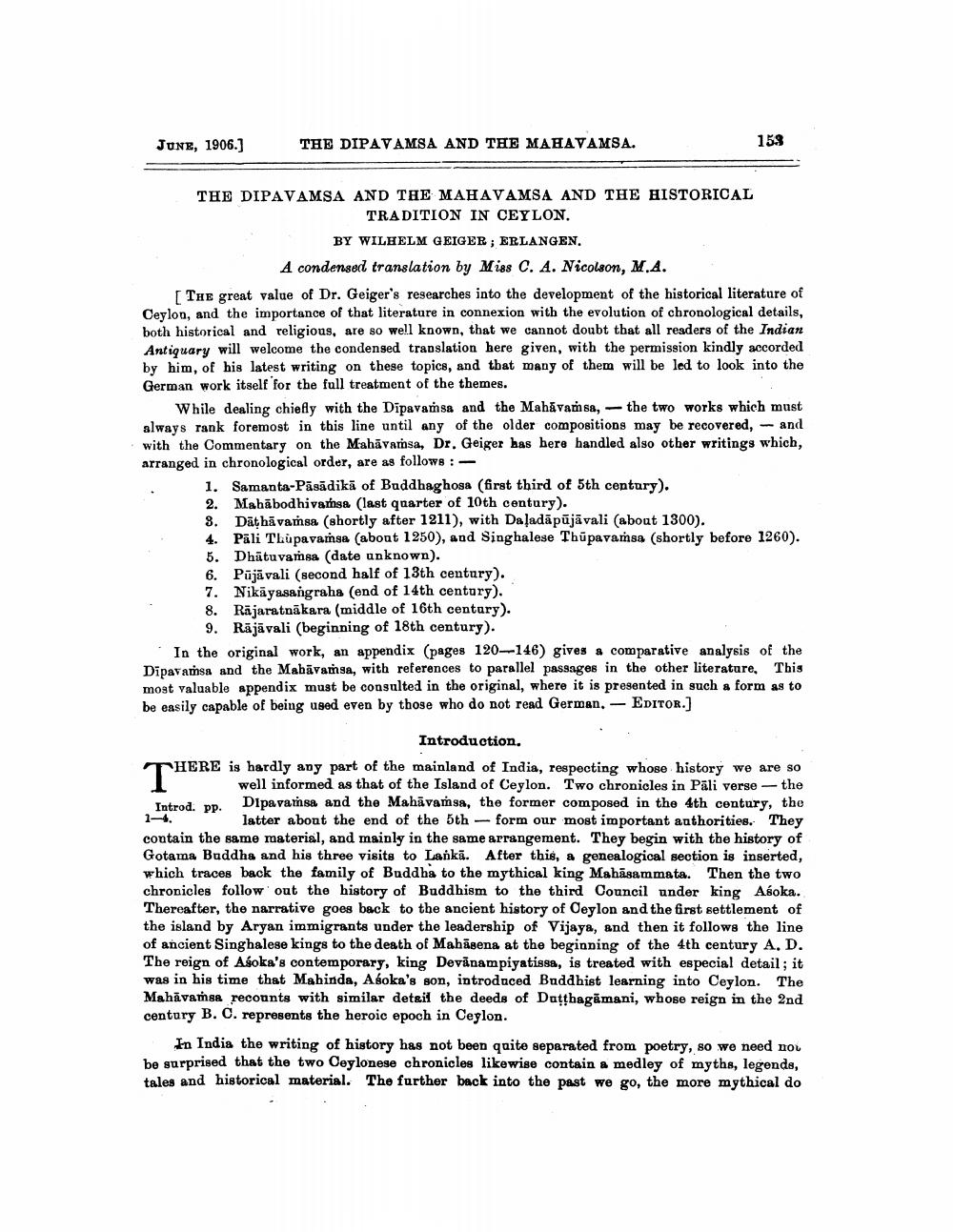________________
JUNE, 1906.)
THE DIPAVAMSA AND THE MAHAVAMSA.
153
THE DIPAVAMSA AND THE MAHAVAMSA AND THE HISTORICAL
TRADITION IN CEYLON.
BY WILHELM GEIGER; ERLANGEN.
A condensed translation by Miss C. A. Nicolson, M.A. [The great value of Dr. Geiger's researches into the development of the historical literature of Ceylon, and the importance of that literature in connexion with the evolution of chronological details, both historical and religious, are so well known, that we cannot doubt that all readers of the Indian Antiquary will welcome the condensed translation here given, with the permission kindly accorded by him, of his latest writing on these topics, and that many of them will be led to look into the German work itself for the full treatment of the themes.
While dealing chiefly with the Dipavamsa and the Mahavamsa, the two works which must always rank foremost in this line until any of the older compositions may be recovered, - and with the Commentary on the Mahāvamsa, Dr. Geiger has bere handled also other writings which, arranged in chronological order, are as follows:
1. Samanta-Pāsādikā of Buddhaghosa (first third of 5th century). 2. Mahābodhivamsa (last quarter of 10th century). 8. Dat hävaṁsa (shortly after 1211), with Daļadāpūjāvali (about 1300). 4. Pāli Tlupavamsa (about 1250), and Singhalese Thüpavamsa (shortly before 1260). 5. Dhūtuvamsa (date unknown). 6. Püjā vali (second half of 13th century). 7. Nikayasangraha (end of 14th century). 8. Rajaratnākara (middle of 16th century).
9. Räjävali (beginning of 18th century). In the original work, an appendix (pages 120-146) gives a comparative analysis of the Dīpavamsa and the Mahāvamsa, with references to parallel passages in the other literature. This most valuable appendix must be consulted in the original, where it is presented in such a form as to be easily capable of being used even by those who do not read German. - EDITOR.]
Introduction. THERE is hardly any part of the mainland of India, respecting whose history we are so
well informed as that of the Island of Ceylon. Two chronicles in Pali verse - the Introd. pp. Dipavamsa and the Mahāvansa, the former composed in the 4th century, the
latter about the end of the 5th form our most important authorities. They contain the same material, and mainly in the same arrangement. They begin with the history of Gotama Buddha and his three visits to Lankā. After this, a genealogical section is inserted, which traces back the family of Buddha to the mythical king Mahasammata. Then the two chronicles follow out the history of Buddhism to the third Council under king Asoka. Thereafter, the narrative goes back to the ancient history of Ceylon and the first settlement of the island by Aryan immigrants under the leadership of Vijaya, and then it follows the line of ancient Singhalese kings to the death of Mahāgena at the beginning of the 4th century A.D. The reign of Asoka's contemporary, king Devānampiyatissa, is treated with especial detail; it was in his time that Mahinda, Asoka's son, introduced Buddhist learning into Ceylon. The Mahāvamse reconnts with similar detail the deeds of Datthagămani, whose reign in the 2nd century B. C. represents the heroic epoch in Ceylon.
In India the writing of history has not been quite separated from poetry, so we need nou be surprised that the two Ceylonese chronicles likewise contain a medley of myths, legends, tales and historical material. The further back into the past we go, the more mythical do




